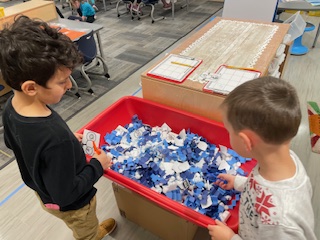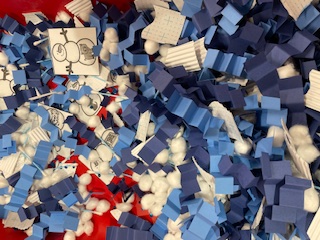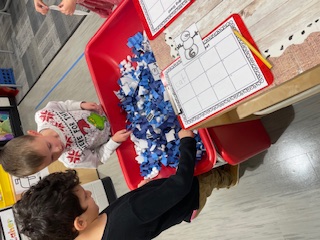Snowmen moved into Danijela Horn's kindergarten classroom at Wilkshire Early Childhood Center last month, making themselves comfortable among the cotton balls, pompoms, crinkle paper, and other materials filling the sensory table purchased this fall through a grant from the Foundation for Haslett Schools.
The snowmen have pictures, and there are hats with consonant-vowel-consonant (CVC) words that match those pictures. Students use fine motor tweezer tongs to pick up the snowmen, then write the beginning sound of the picture, match the CVC word with the picture, or match and write the word.
That creative literacy lesson is just one way Horn has incorporated the sensory table into learning. It's also a space to practice counting, and those tongs help students develop fine motor skills as they pick up cotton balls, pompoms, and other fun items.
"The sensory bin is able to meet the needs of all learners in our classroom," Horn said.
Sensory tables – and the wide range of colorful elements that fill them – were purchased for all eight kindergarten classrooms this fall. Along with the portable table – which measures nearly 3 feet by 2 feet and is 7 inches deep – every kindergarten classroom received fluffy pompoms, multi-colored water beads, feathers, and numbers; wooden rice, cotton balls, and hedge balls; magnets and magnetic wand, and magnetic letters.
The benefits of sensory play are many and wide-ranging, inspiring creativity, cooperation, communication, and physical development. All of the grasping, pouring, and scooping our students are practicing at this early stage of their educational growth is incredible.
All of the above materials provide our teachers with tools to use in a variety of ways, including these shared by staff:
Karen Amachree in the Superstar Room makes the sensory tables an option during free choice and eventually will incorporate them into literacy and math center time.
"The students have been benefitting from the sensory items as well as combining the bins with items for number ID, letter ID, sound ID and so on...We have really been enjoying them!"
In the Rainbow Room, Amy Fielbrandt is also making the tables available during free choice and for fast finishers of other classwork. She has also begun using the table as a literacy center:
"Right now, they are finding letters, sorting jingle bells and rice!"
Sarah Grabemeyer in the Bumblebee Room noted those fine motor opportunities in her classroom as the sensory materials are being incorporated into workshop times. Her students also identify rhymes, stretch out CVC words, and match them to the corresponding pictures. She wrote,
"[They] seem to really enjoy 'digging in' and using those small motor skills, combined with the academic piece!"
The message of the Foundation's donor campaign this fall has been "Look What's Possible" – and it's impossible to miss the enthusiasm beaming from these teachers' words and students' faces.
These sensory tables and materials cost $3,982, and contributions to the Foundation made them possible. Our community's youngest learners will benefit from them this school year and for several to come – and with your help, we can provide even more opportunities and experiences. Join us in supporting our learners by contributing to our campaign!









Comments